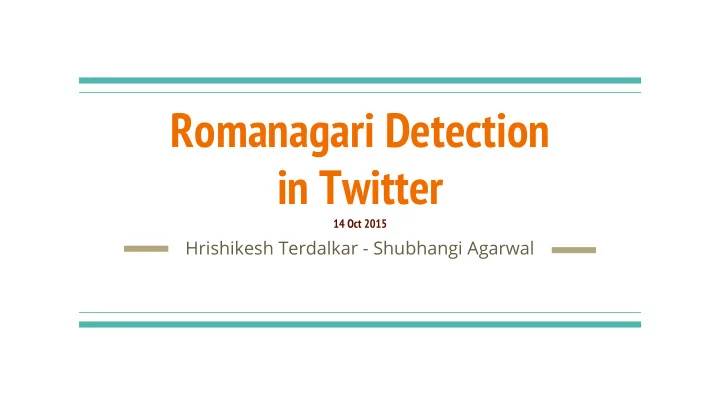

Romanagari Detection in Twitter 14 Oct 2015 Hrishikesh Terdalkar - Shubhangi Agarwal
Motivation Why Twitter? ● Most NLP techniques deal with English text only ● Tweets are often of the form: ● “Yeh kaisi field placings lagayi hain? Powerplay mein slip? Via @ARangarajan1972 #IndvsPak ”
Romanagari = Noise
Goal Collect and create a quality tweet-dataset containing Romanagari words ● Romanagari Text Detection ● (possibly) Translate to English language ● Languages Targeted Hindi ●
Steps Create a dictionary of Romanagari words Detect Romanagari text mixed with English text Translate to English
Sounds easy?!
Challenges 1. Data Collection i. Search terms ii. Noise (different languages) iii. Disambiguation (polysemy in Hindi and English) 2. Detect and differentiate between English and Romanagari text i. Phonetic typing ii. SMS language iii. Spelling errors iv. Disambiguation
Challenges 3. Handle commonly occurring inflections in the social media text i. whattttttt!, whennnn??, kyunnnn?? ii. mann, bool, bol 4. And many more (yet to be encountered)
Approach 1. Data i. Collection Frequent Romanagari words ➢ Tweepy ➢ SMS language ➢ ii. Synthetic Generation 2. Language detection/correction i. Tools available (PyEnchant, langid, langdetect, guess-language etc) 3. Almost phonetic representations i. Metaphone ii. Double Metaphone iii. Soundex Also used for Romanagari text detection ➢
Strategies Find frequently used Romanagari words in tweets/social media. ● (Different from “most frequent” Hindi words from other corpora such as books / wiki) Try to obtain annotated-datasets from social media such as facebook ● from existing papers and frequency analysis on this smaller “spoken- hindi” dataset. Context analysis (if possible) ● n-grams ➢
So far.. Python ➔ Twitter collection ➔ most frequent hindi words as FILTER ◆ low success rate on tweets + lot of noise ◆ explored synthetic generation [3] ◆ Exploration of existing classifiers ➔ PyEnchant : a spellchecking library for Python based on Enchant ◆ langdetect : python implementation of “language-detection” Java library ◆ langid : language identification, n-gram, 97 languages, scores for multiple languages ◆ Soundex / Metaphone Experiments ➔
Soundex vs Double Metaphone “kyun” “haan” “what”
Soundex vs Double Metaphone “burp” “boom” “lol” “ah / oh”
Tweet Collection
Plan Better dataset collection strategies ➔ Better synthetic generation than mentioned in [3] ➔ Perform experiments to test feasibility of Soundex/Metaphone for Hindi ➔ Pre-processing tweets followed by language identifiers with modification ➔ Compose a list of Hindi-specific disambiguation rules ➔ Detect Romanagari words ➔ Annotate / Attach English meaning to Romanagari words ➔
References 1. Barman, Utsab, et al. "Code Mixing: A Challenge for Language Identification in the Language of Social Media." EMNLP 2014 (2014): 13. 2. Gella, Spandana, Jatin Sharma, and Kalika Bali. "Query word labeling and back transliteration for indian languages: Shared task system description." FIRE Working Notes (2013). 3. Gella, Spandana, Kalika Bali, and Monojit Choudhury. "“ye word kis lang ka hai bhai?” Testing the Limits of Word level Language Identification." 4. Das, Amitava, and Björn Gambäck. "Identifying Languages at the Word Level in Code-Mixed Indian Social Media Text." Proceedings of the 11th International Conference on Natural Language Processing, Goa, India . 2014. 5. Han, Bo, and Timothy Baldwin. "Lexical normalisation of short text messages: Makn sens a# twitter." Proceedings of the 49th Annual Meeting of the Association for Computational Linguistics: Human Language Technologies-Volume 1 . Association for Computational Linguistics, 2011. 6. Proceedings of Social india 2014 Tweepy: https://github.com/tweepy/tweepy 7. Chaware, Sandeep, and Srikantha Rao. "RuleBased Phonetic Matching Approach for Hindi and Marathi." 8. Computer Science & Engineering, 1.3 (2011), AIRCC
Questions?
Thank You
Recommend
More recommend